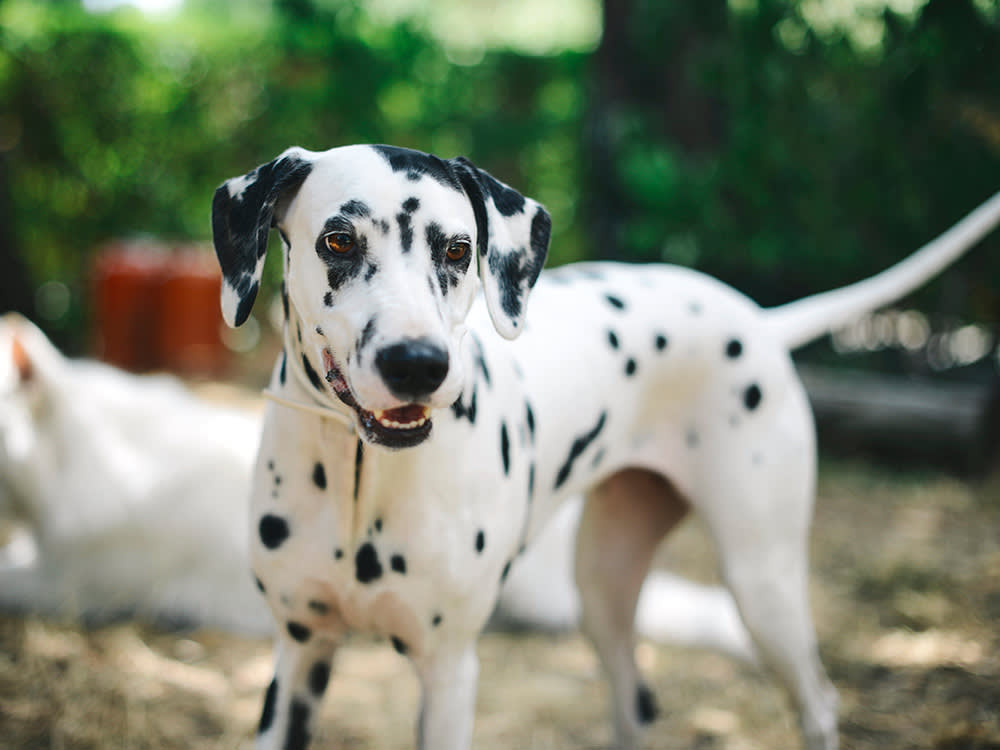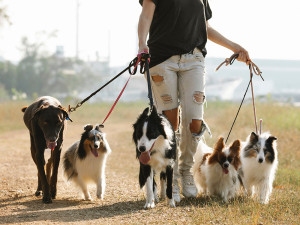DNA Test Helps Dalmatians
Researchers identify the gene that causes bladder stones, thanks to a few Dalmatians.

Share Article
How do you recognize a Dalmatian? If you think of the movie 101 Dalmatians or the dog who traditionally rides on the fire engine, it’s easy. Dalmatians are, of course, known for their characteristic spots— breeders have spent many years selecting for dogs with spotting patterns that fit the ideal breed standard: evenly distributed, distinct, well-defined round spots that are larger than a dime but smaller than a half dollar. However, sometimes the bad unexpectedly comes along with the good.
Dalmatian Predisposition to Bladder Stones
Breeding for these patterns has brought with it a predisposition to form bladder stones, a condition that is potentially life-threatening. With the help of a special group of Dalmatians and some dedicated breeders, scientists have unearthed the cause of this condition and designed a DNA test that will not only improve Dalmatian health but will benefit other dogs as well.
In most dogs, the proteins in food are broken down in the liver, and the byproduct, allantoin, is excreted by the kidneys into the urine, where it dissolves. In Dalmatians, the process stops at the step before the production of allantoin; instead, uric acid is produced. Because uric acid does not dissolve well in urine, it can form urate stones in the bladder, and these stones can block the urethra; in serious cases, this condition requires surgery to resolve. The accumulation of high levels of uric acid in the urine is called hyperuricosuria (huu).
Huu, which was first described in 1916, was shown in 1938 to have a recessive mode of inheritance (an individual must have two copies of the mutation to be affected). Because of a lack of genetic diversity, all Dalmatians carry two copies of the huu mutation, meaning that within the purebred Dalmatian population, there is no way to breed dogs with low levels of uric acid because the trait does not exist in their gene pool. Consequently, Dalmatians produce 20 times more uric acid per day than other dogs and are prone to urate stones. (Interestingly, although all Dalmatians have high levels of uric acid, not all exhibit clinical disease. The reason for this is unknown.)

Introducing LUA Dalmatians
In order to correct this condition, a normal, low-uric-acid copy of the gene had to be introduced into the gene pool. In 1973, Dr. Robert Schaible, a medical geneticist and Dalmatian breeder, bred a Dalmatian to a Pointer and then bred the offspring back to purebred Dalmatians. The goal of this backcross was to produce dogs who looked like Dalmatians, but who had normal (i.e., low) uric acid levels in their urine and therefore would not produce bladder stones. Each time one of these backcross Dalmatians (with low levels of uric acid, or LUA dogs) is bred to a purebred Dalmatian (with high levels of uric acid, or HUA dogs), about 50 percent of the puppies are LUA and 50 percent are HUA.
LUA dogs tend to have smaller spots than HUA dogs, providing further evidence that the huu mutation was unintentionally selected for along with the deliberate selection for spot patterns. Although the spots on LUA dogs are generally smaller, they still fall within the guidelines of the Dalmatian standard as outlined by the American Kennel Club (AKC).
Danika L. Bannasch, DVM, PhD, associate professor of genetics at the University of California, Davis, School of Veterinary Medicine—and Dalmatian owner and former breeder—became involved with the project in 1998. Using blood samples and pedigree information from generations of backcross Dalmatians, Dr. Bannasch and her colleagues recently identified a mutation in the SLC2A9 gene that causes huu in Dalmatians. The mutation correlates perfectly with a dog’s huu status: Only HUA dogs have two copies of the mutation. “The biggest challenge to finding the genetic cause for huu in Dalmatians was the fact that the trait is fixed in the breed,” says Bannasch.“If we didn’t have the backcross, it would have been impossible to do.”
AKC Prohibition
Two backcross Dalmatian puppies from the fifth generation were registered with the AKC, which meant that they could be shown in AKC-recognized events. The registration was later opposed, and further registration of backcross dogs was prohibited. The issue of AKC backcross Dalmatian registration continues to be controversial, but they were officially accepted in 2011. Backcross Dalmatians can also be registered with the United Kennel Club.
Since most serious breeders register their dogs with the AKC, the number of purebred Dalmatians prior to 2011 available to backcross breeders became severely limited because the puppies were not eligible for AKC registration. By 2005, after 30 years of work, few breeders were using backcross dogs in their programs, and Dr. Schaible was limited by the number of dogs he could keep himself, factors that suggested the project was nearing an end. Around that time, Denise Powell, a northern California Dalmatian breeder for more than 20 years, contacted Dr. Schaible to inquire about breeding backcross Dalmatians. “I was shocked to learn that he had just two aging stud dogs and two infant female pups,” says Powell. “I decided then and there to do what I could to help preserve the only line of LUA Dalmatians in the world from dying out. I asked, and Bob agreed to let me have one of the two pups.”
Powell’s dedication led to the creation of the Dalmatian Heritage Project, which in turn sparked the involvement of other Dalmatian breeders and the expansion of the backcross population. Current descendants of the original cross represent the 12th generation of the family. There is only one Pointer out of more than 4,000 relatives in the pedigrees of the backcross dogs, which makes them more than 99 percent Dalmatian.
Backcross dogs undergo all the health screenings recommended for AKC registered Dalmatians, including Brainstem Auditory Evoked Response (BAER) hearing testing, temperament analysis, conformational analysis, and, in some cases, Orthopedic Foundation for Animals (OFA) hip exams and Canine Eye Registration Foundation (CERF) eye evaluations.
Saving More than Dalmatians
The scientific data reporting the identification of the huu mutation has been published in the peer-reviewed genetics journal of the Public Library of Science (PLoS), and a DNA test for the mutation is now available through the Veterinary Genetics Laboratoryopens in new tab at UC Davis. Previously, a laborious and expensive urine test was required to determine whether a dog was LUA or HUA. The DNA test eliminates the need for the urine test and makes selection easier in the backcross Dalmatians.
The positive impact of this genetic discovery extends beyond Dalmatians. High levels of uric acid and urate stone formation have been reported in individuals from other breeds, including Bulldogs and Black Russian Terriers. Testing in Dr. Bannasch’s laboratory has confirmed that the mutation responsible for huu in these breeds is the same one identified in Dalmatians.
“Now we have a means for identifying the probable major cause for urate disease in dogs,” says Bannasch.“If you know your dog is predisposed to form bladder stones, you can alter things about their management and be aware of the signs of stone disease.”
The huu mystery described in Dalmatians more than 90 years ago has been solved through visionary thinking and tireless dedication. Advances in genetics enabled the creation of a DNA test that will benefit not only Dalmatians but other dogs as well. The story of the backcross Dalmatians exemplifies the profound impact on canine health that breeders, owners, veterinarians, and scientists can achieve by working together.

Amy Young, MS
Amy Young is a geneticist and Equine Outreach Manager at the University of California, Davis.
Related articles
![]()
Cancer is More Common in Purebred Dogs, Study Says
Nationwide’s veterinary analytics team looked at the cancer claims of 1.61 million dogs and found that purebred dogs are nearly twice as likely to get cancer as mixed breeds.
![A woman hugging her dog.]()
Want Your Dog to Live Longer?
Seriously, though. The Dog Aging Project is looking for participants.
![A woman walking 5 dogs on leashes outside.]()
Breed Does Not Equal Behavior—Here’s Why
A new study found that a dog’s breed accounts for less than 10 percent of their behavior.
![Two golden retriever dogs cuddling]()
Cancer in Dogs: A Large-Scale Study Offers Hope
Research on Golden Retrievers may help reduce the risk of cancer in all dogs.




